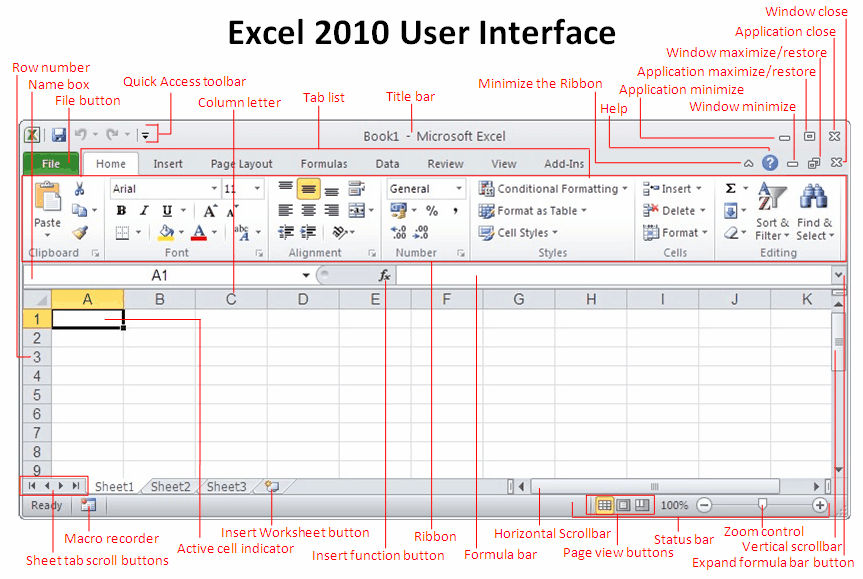Beginners to Excel are often intimidated by all the different elements that appear within Excel’s user interface. After you become familiar with the various parts, it all starts to make sense.
Excel 2010 User interface
Below figure shows a typical Excel 2010 user interface, with the important parts labeled. This terminology rears its ugly head throughout all excel tutorials, so you should review the figure from time to time.

Excel 2010 User interface Description
| Name | Description |
|---|---|
| Active cell indicator | This dark outline indicates the currently active cell (one of the 17,179,869,184 cells on each worksheet). |
| Application Close button | Clicking this button closes Excel. |
| Application Minimize button | Clicking this button minimizes the Excel window. |
| Column letters | Letters range from A to XFD — one for each of the 16,384 columns in the worksheet. You can click a column heading to select an entire column of cells, or drag a column border to change its width. |
| Expand formula bar button | Clicking this button expand formula bar to display more. |
| File button | Click this button to open Back Stage view, which contains many options for working with your document (including printing), and setting Excel options. |
| Formula bar | When you enter information or formulas into a cell, it appears in this line. |
| Help button | Clicking this button displays the Excel Help system window. |
| Horizontal scrollbar | Use this tool to scroll the sheet horizontally. |
| Insert function button | Clicking this button insert function. |
| Insert Sheet button | By default, each new workbook that you create contains three sheets. Add a new sheet by clicking the Insert Worksheet button (which is displayed after the last sheet tab). |
| Macro recorder indicator | Click to start recording a VBA macro. The icon changes while your actions are being recorded. Click again to stop recording. |
| Minimize Ribbon button | Clicking this button hides the Ribbon, giving you a bit more space onscreen. When you click a tab, the Ribbon reappears. |
| Name box | This field displays the active cell address or the name of the selected cell, range, or object. |
| Page View buttons | Change the way the worksheet is displayed by clicking one of these buttons. |
| Quick Access toolbar | This customizable toolbar holds commonly used commands. The Quick Access toolbar is always visible, regardless of which tab is selected. |
| Ribbon | This is the main location for Excel commands. Clicking an item in the tab list changes the Ribbon that displays. |
| Row numbers | Numbers range from 1 to 1,048,576 — one for each row in the worksheet. You can click a row number to select an entire row of cells. |
| Sheet tab scroll buttons | Use these buttons to scroll the sheet tabs to display tabs that aren’t visible. |
| Sheet tabs | Each of these notebook-like tabs represents a different sheet in the workbook. A workbook can have any number of sheets, and each sheet has its name displayed in a sheet tab. |
| Status bar | This bar displays various messages as well as the status of the Num Lock, Caps Lock, and Scroll Lock keys on your keyboard. It also shows summary information about the range of cells that is selected. Right-click the status bar to change the information that’s displayed. |
| Tab list | Use these commands to display a different Ribbon, similar to a menu. |
| Title bar | This displays the name of the program and the name of the current workbook, and also holds some control buttons that you can use to modify the window. |
| Vertical scrollbar | Use this to scroll the sheet vertically. |
| Window Close button | Clicking this button closes the active workbook window. |
| Window Maximize/Restore button | Clicking this button increases the workbook window’s size to fill Excel’s complete workspace. If the window is already maximized, clicking this button “unmaximizes” Excel’s window so that it no longer fills the entire screen. |
| Window Minimize button | Clicking this button minimizes the workbook window, and it displays as an icon. |
| Zoom control | Use this scroller to zoom your worksheet in and out. |
Thank you sir
yes
no ty
Good
Am really thankful
Thank you so much for thiss
is good to use excel for business
is good to use excel.